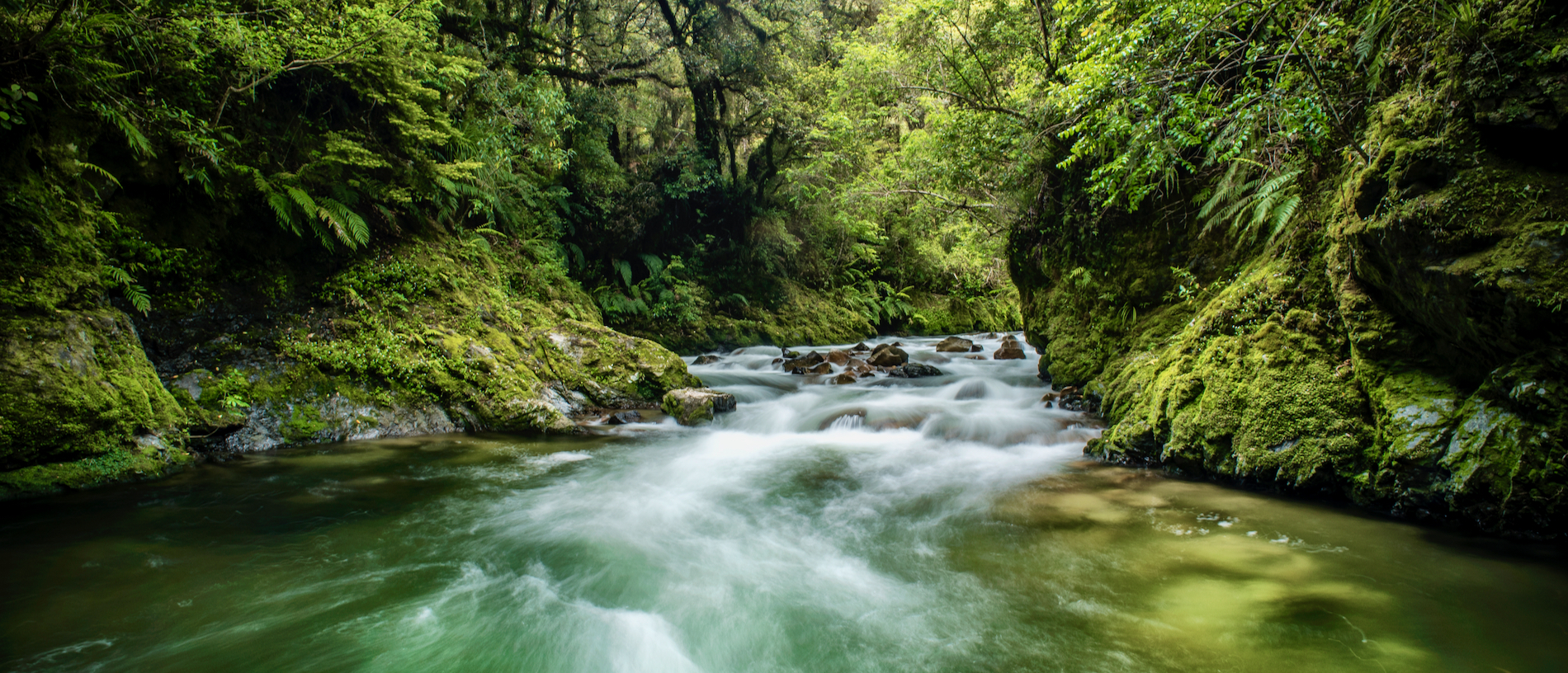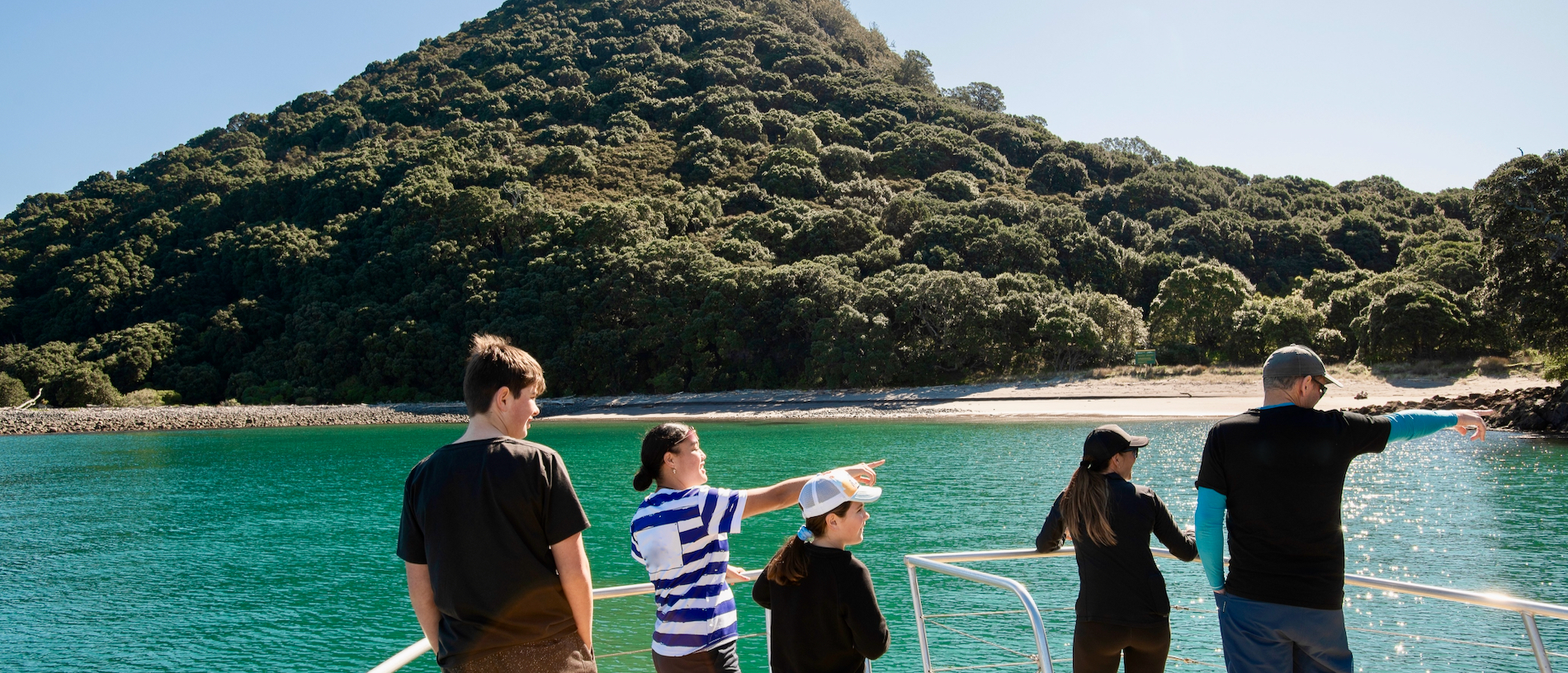
Explore the primordial bush in Whirinaki Forest Park
Wild, untamed and precious, the Whirinaki Te Pua-a-Tāne Conservation Park deep in the Bay of Plenty is a rugged jewel of the North Island.

Secret beaches, offshore islands, hidden lakes, swimming holes, waterfalls and a gorgeous water garden – these are just some of 14 Kiwi Gems that you've probably never heard of in the Bay of Plenty and Coromandel regions.
Across the tidal waters of Tauranga Harbour lies Matakana Island – an intriguing 20-kilometre-long land mass between Bowentown in the north and Mount Maunganui in the South. The largest of the islands in the Bay of Plenty, Matakana Island is home to approximately 300 residents, with kiwifruit orchards, pine forests and farms making up its interior. However, the main reason for planning a day trip is the spectacular white-sand surf beach on the northern side of the island. You can reach Matakana Island by boat or kayak, or climb aboard the historic MV Kewpie for a one hour scenic cruise to spend either an hour or a day on this little slice of sandy paradise.
Although now largely hidden from view by the development of the town, Te Wairere Falls remain one of the most beautiful and historically significant sites in Whakatāne. They are a sacred landmark to all of Mātaatua. The fresh water first supplied the Ngāti Awa people and later the township until 1924. You’ll find both locals and visitors at the falls, and they are lit in the evenings which adds something special to the experience of appreciating the mossy rock formations and restful waters.

Loved by local thrill-seekers and largely undiscovered by out-of-towners, the Pori Pori waterhole in Lower Kaimāī is one of the best swimming spots in the Bay of Plenty. Access is easy if you don’t mind a river crossing. Best suited to confident swimmers, as the water is deep and you’ll have to jump off the rocks to get in, but there are some shallow rock pools for safe swimming and exploring, too. One of New Zealand’s best stretches of accessible white water can also be found right here on the Wairoa River, above State Highway 29. Every Sunday during summer, the power company opens the dam at nearby McLaren Falls which makes rafting and kayaking heaps of fun.
Te Ana O Muriwai, or Muriwai's Cave, is historically significant for Whakatāne. It’s a landmark dedicated to the memory of Muriwai, a respected ancestor of the Mātaatua tribes, and the cave was tapu until this was lifted in 1963. Just across the road near the water's edge, you’ll find a carved shelter holding a ceremonial replica of the Mātaatua waka. Muriwai was the sister of Toroa, captain of the Mātaatua canoe, and it is said she lived in the cave from the time they arrived from Hawaiki until her death. Look up the legends and mythology around it. It’s fascinating.

Formed by a hydroelectric dam on the Rangitaiki River, Lake Matahina, 30km inland from Whakatāne is a tranquil spot framed by steep columned cliffs and forest. The narrow lake is popular for kayaking, as you can explore the perimeter to find beautiful hidden waterfalls and a small island covered in trees. Near the lake head, venture ashore to find another stream and if you follow this for a short scramble through the bush you’ll come to a stunning 50-metre-high waterfall. For experienced kayakers, allow an hour or so for the return trip, though families should expect to make a day of it.
A short, steep bush walk on the outskirts of Te Puke takes you to the beautiful Raparapahoe Falls. Descend through mature tawa forest, taking care as it can be slippery after rain – jandals are not advisable! Once you reach the bottom head upstream to find the three-metre-high waterfall and a large, clear waterhole perfect for swimming. The walk takes approximately 60 minutes return and you’re welcome to bring your dog with you for this one.

Head offshore for another island adventure in the Bay of Plenty on a day trip to Moutohorā / Whale Island. Set sail from Whakatāne to reach the pest-free wildlife sanctuary – home to kiwi, tieke / North Island saddleback, tuatara and kekeno fur seals. Moutohorā Island is the remnant of an ancient volcanic cone, long since eroded, with its distinctive double peaks visible from the mainland. Ashore, you can visit the seal colony and discover geothermal activity at Onepū Bay, Moutohorā’s own hot water beach. Make sure you bring your togs! Only three local operators have permission to escort small groups to the island in order to preserve its strict sanctuary status.
For native birds, gigantic trees, easy walking tracks, stunning waterfalls and absolute peace and quiet, Ōtānewainuku Forest in Ōropi is a must-do. Ōtānewainuku means 'the many waters that spring forth from the domain of Tāne – overseer of the forest.' At about 20km south of Tauranga, this special place is off the beaten track and it’s a bit of a hidden gem. The unlogged forest is cared for by a community trust, which makes it a sanctuary where native birds and wildlife thrive.
A secret cove that can only be reached on foot is always an enticing proposition. With a white sandy beach set against dense pōhutukawa forest, Homunga Bay is a special spot that is worth the effort to reach. A walking track from the northern end of Orokawa Bay leads you along the stunning Coromandel coastline. The walk takes around 1.5 hours each way, so ensure you pack plenty of water, snacks and wear comfortable walking shoes.

The Aldermen or Ruamaahu Islands off the coast of Pāuanui are often referred to as the vanishing volcanoes. Hongiora, Ruamahuaiti, Ngā Horo, The Spire and Ruamahuanui islets are remnants of a much larger volcanic complex which erupted around five million years ago.The rocky islands were originally named ‘The Honorable Court of Aldermen’ by Captain Cook on his 1769 visit. Protected since 1933, the Aldermen group is one of the most important wildlife sanctuaries in the Coromandel region, administered, like the Mercury Islands, as part of the Hauraki Gulf Maritime Park. Home to endangered reptiles, rare native plants and many nesting sea birds, going ashore is strictly prohibited, however, with huge drop-offs and an equally large range of fish life, the diving here is spectacular. Features include caves, pinnacles and a major feeding station just below the surface. Several charters operate out of Whitianga, Hahei, Tairua, Pāuanui and Whangamatā to take you out to experience this strange and wonderful place.
On the banks of the Ohinemuri River opposite Waikino in The Coromandel you’ll find the remnants of one of New Zealand’s most impressive industrial sites. Constructed between 1897 and 1898, the Victoria Battery was the largest gold ore crushing battery in the country and was operational for 54 years until its closure in 1952. Today you can walk amongst the hulking concrete remains of cyanide tanks and ore roasting kilns. The original transformer house is now a museum where you can learn more about this intriguing site and the extensive gold mining activity that happened here. On open days you can also take a guided tour to explore underground tunnels or ride the small tram that winds amongst the relics.

The most distinctive geological feature at Tairua on the Coromandel Peninsula is Mount Paku – the two spiky volcanic peaks that mark the entrance to Tairua Harbour. Tackle the short, steep climb to the summit and you’ll be rewarded with incredible views over the harbour, Tairua, Pāuanui and the golden sands of the Coromandel coastline. The route is lined with native bush studded with pōhutukawa, karaka and māhoe, and higher, large boulders which turn the walk into an adventure. The walk takes around 30 minutes return and, yes, you can take your dog if they’re on a lead.
Head inland from the small settlement of Tapu on the coast about 20 minutes north of Thames to find a garden wonderland brimming with delights. The Rapaura Water Gardens have been a labour of love for more than 50 years, as exotic flowers have been cultivated alongside dense native bush. Today those efforts have paid off, as Rapaura has been recognised as a ‘Garden of Significance’ by the New Zealand Gardens Trust. Follow meandering pathways over wooden bridges to find lovely lily ponds and waterfalls, or absorb the bounty of colour and creativity with garden art and the mesmerising blooms of irises, rhododendrons, orchids and begonias.
A precious gem at the base of the Coromandel on the Firth of Thames, this ornithological mecca is home to seaside marshes and mangroves where discreet hides allow visitors to spy on the migratory birds. Depending on the season you might see plovers, red knots (who soar all the way to Siberia to breed), torea / pied oystercatchers, tuturiwhatu / dotterels or ngutu parore / wrybills whose beaks famously bend to the right. A nursery for young godwits who’ve yet to think about starting families, these canny fledglings know there’s little point flying all the way to Alaska till they reach the age of consent. All the birds have astonishing stories and the award-winning Pukorokoro Miranda Shorebird Centre explains their epic exploits in detail.